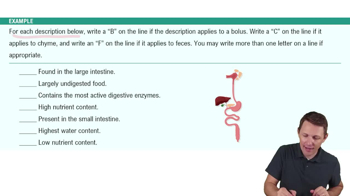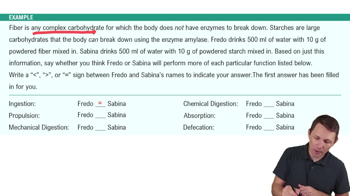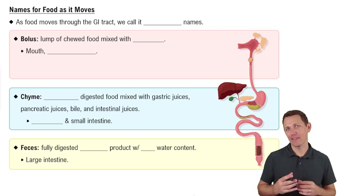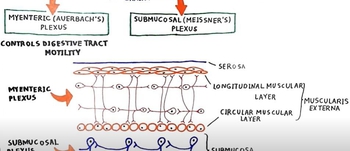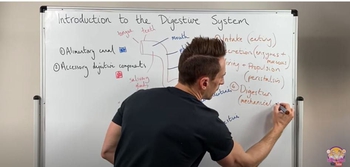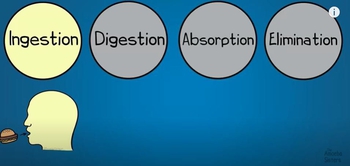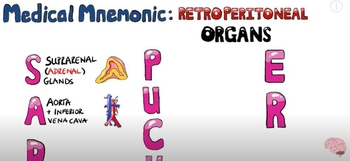Control of the digestive system progresses from the head to the stomach to the small intestine as food enters and moves through the GI tract. We can distinguish three phases of control: cephalic, gastric, and intestinal. During the cephalic phase of control, receptors for the sight, smell, taste, and even the thought of food initiate reflexes that cause salivation, production of gastric juice, and gastric contractions. These responses are mediated by the Vagus nerve and prepare the GI system for the arrival of a meal. During the gastric phase of control, the meal is in the stomach. The stomach contents and volume initiate reflexes that cause production of gastric secretions and increase gastric motility. During the intestinal phase of control, the meal moves into the intestine. The intestinal contents and volume initiate reflexes that cause secretion of bicarbonate, digestive enzymes, and bile, and begin segmenting contractions in the small intestine. Inhibitory reflexes from the intestine slow gastric emptying while the intestinal contents are neutralized, digested, and absorbed. The phases of control occur in sequence only at the beginning of a meal. Once a meal is underway, the phases are simultaneous. The stomach and intestine work together, back and forth, to digest and absorb the contents of a meal. Recall that the autonomic nervous system has a two-neuron chain between the central nervous system and effector organs. These are the neurotransmitters of the autonomic nervous system. Acetylcholine is the neurotransmitter for all preganglionic fibers and for parasympathetic postganglionic fibers. Norepinephrine is the neurotransmitter for sympathetic postganglionic fibers. Many neurotransmitters found in the brain are also found in the enteric nervous system. Interneurons may use acetylcholine, serotonin, vasoactive intestinal peptide, nitric oxide, and somatostatin. Neurons that are excitatory to smooth muscle use acetylcholine and substance P. Neurons that are inhibitory to smooth muscle use vasoactive intestinal peptide and nitric oxide. Another family of neurotransmitters, the enkephalins found in nerve fibers of the mucosa and smooth muscle act to slow intestinal motility; contract the lower esophageal sphincter, pyloric, and ileocecal sphincters; and inhibit intestinal secretion. Note that acetylcholine has profound effects on the digestive system because of its widespread use by parasympathetic, sympathetic, and enteric neurons. The enteric neurons use many different neurotransmitters, some neurons releasing more than one. This results in complex actions by the GI neurotransmitters. Like parasympathetic and sympathetic nerves, hormones modulate the activity of the digestive system. Here are some characteristics of GI hormones. GI hormones are peptides. There are many peptides in the GI system. To be recognized as a hormone, a peptide must meet rigorous criteria. Some GI peptides have been found to be neurotransmitters, and others are considered candidate hormones. We will study the five currently identified GI hormones: gastrin, cholecystokinin or CCK, secretin, glucose-dependent insulinotropic peptide or GIP, and motilin. Note that each bead in the images of the hormones represents one amino acid. Individual enteroendocrine cells in the mucosa secrete the GI hormones. GI hormones are not released from endocrine glands. They are released from single cells located over large areas of the gastrointestinal mucosa. GI hormones support the function of the particular organ that releases them. Gastrin, CCK, and secretin also have trophic effects. Let’s look at each hormone to see where it is released, and to review its actions. G cells in the pyloric antrum of the stomach secrete gastrin. Gastrin stimulates hydrochloric acid secretion in the stomach, and growth of the gastric and colonic mucosae. I cells in the duodenum and jejunum secrete CCK. CCK causes the gallbladder to contract moving bile into the small intestine. It also causes the exocrine pancreas to secrete digestive enzymes into the small intestine. CCK stimulates growth of the exocrine pancreas and mucosa of the gallbladder, and inhibits gastric emptying. S cells in the duodenum secrete the hormone secretin. Secretin causes both the liver and the exocrine pancreas to secrete bicarbonate into the small intestine, and stimulates growth of the exocrine pancreas. Secretin inhibits gastric acid secretion. Because its actions reduce acidity, secretin is called “nature’s antacid.” Cells of the duodenum and proximal jejunum secrete GIP. In the presence of glucose, GIP stimulates secretion of insulin by the endocrine pancreas. During a meal, GIP causes an earlier and larger secretion of insulin than if glucose were the only stimulus for secretion of insulin. Cells of the duodenum and jejunum secrete motilin about every 90 minutes during the postabsorptive or fasting state. Motilin stimulates production of the migrating motility complex, which sweeps the contents of the small intestine toward the terminal ileum. GI hormones enter the circulatory system, not the lumen of the GI tract. Neural activity, breakdown products of foodstuffs, or distension of the GI tract cause secretion of hormones. Note that hormones are not released into the lumen of the tract. They enter the portal blood and are transported to the liver and heart before returning to the GI tract to act. Some GI hormones exhibit potentiation. Potentiation occurs when the combined action of two hormones is greater than the sum of their individual effects. For example, secretin stimulates bicarbonate released from the pancreas. When secretin levels are low, the addition of CCK produces a large increase in the secretion of pancreatic bicarbonate solution. CCK also potentiates secretin to stimulate growth of the exocrine pancreas. Note that gastrin is structurally related to CCK, and secretin is related to GIP. Lighter beads indicate identical amino acids. The structural similarities among GI hormones, and the probable presence of receptors for all GI hormones on most cells of the GI tract, account for the amazing complexity of actions of GI hormones.
Table of contents
- 1. Introduction to Anatomy & Physiology5h 40m
- What is Anatomy & Physiology?20m
- Levels of Organization13m
- Variation in Anatomy & Physiology12m
- Introduction to Organ Systems27m
- Homeostasis9m
- Feedback Loops11m
- Feedback Loops: Negative Feedback19m
- Feedback Loops: Positive Feedback11m
- Anatomical Position7m
- Introduction to Directional Terms3m
- Directional Terms: Up and Down9m
- Directional Terms: Front and Back6m
- Directional Terms: Body Sides12m
- Directional Terms: Limbs6m
- Directional Terms: Depth Within the Body4m
- Introduction to Anatomical Terms for Body Regions3m
- Anatomical Terms for the Head and Neck8m
- Anatomical Terms for the Front of the Trunk8m
- Anatomical Terms for the Back9m
- Anatomical Terms for the Arm and Hand9m
- Anatomical Terms for the Leg and Foot15m
- Review- Using Anatomical Terms and Directions12m
- Abdominopelvic Quadrants and Regions19m
- Anatomical Planes & Sections17m
- Organization of the Body: Body Cavities13m
- Organization of the Body: Serous Membranes14m
- Organization of the Body: Serous Membrane Locations8m
- Organization of the Body: Thoracic Cavity8m
- Organization of the Body: Abdominopelvic Cavity12m
- 2. Cell Chemistry & Cell Components12h 37m
- Atoms- Smallest Unit of Matter57m
- Isotopes39m
- Introduction to Chemical Bonding19m
- Covalent Bonds40m
- Noncovalent Bonds5m
- Ionic Bonding37m
- Hydrogen Bonding19m
- Introduction to Water7m
- Properties of Water- Cohesion and Adhesion7m
- Properties of Water- Density8m
- Properties of Water- Thermal14m
- Properties of Water- The Universal Solvent17m
- Acids and Bases12m
- pH Scale21m
- Carbon8m
- Functional Groups9m
- Introduction to Biomolecules2m
- Monomers & Polymers11m
- Carbohydrates23m
- Proteins25m
- Nucleic Acids34m
- Lipids28m
- Microscopes10m
- Prokaryotic & Eukaryotic Cells26m
- Introduction to Eukaryotic Organelles16m
- Endomembrane System: Protein Secretion34m
- Endomembrane System: Digestive Organelles15m
- Mitochondria & Chloroplasts21m
- Endosymbiotic Theory10m
- Introduction to the Cytoskeleton10m
- Cell Junctions8m
- Biological Membranes10m
- Types of Membrane Proteins7m
- Concentration Gradients and Diffusion9m
- Introduction to Membrane Transport14m
- Passive vs. Active Transport13m
- Osmosis33m
- Simple and Facilitated Diffusion17m
- Active Transport30m
- Endocytosis and Exocytosis15m
- 3. Energy & Cell Processes10h 7m
- Introduction to Energy15m
- Laws of Thermodynamics15m
- Chemical Reactions9m
- ATP20m
- Enzymes14m
- Enzyme Activation Energy9m
- Enzyme Binding Factors9m
- Enzyme Inhibition10m
- Introduction to Metabolism8m
- Redox Reactions15m
- Introduction to Cellular Respiration22m
- Types of Phosphorylation11m
- Glycolysis19m
- Pyruvate Oxidation8m
- Krebs Cycle16m
- Electron Transport Chain14m
- Chemiosmosis7m
- Review of Aerobic Cellular Respiration19m
- Fermentation & Anaerobic Respiration23m
- Introduction to Cell Division22m
- Organization of DNA in the Cell17m
- Introduction to the Cell Cycle7m
- Interphase18m
- Phases of Mitosis48m
- Cytokinesis16m
- Cell Cycle Regulation18m
- Review of the Cell Cycle7m
- Cancer13m
- Introduction to DNA Replication22m
- DNA Repair7m
- Central Dogma7m
- Introduction to Transcription20m
- Steps of Transcription19m
- Genetic Code25m
- Introduction to Translation30m
- Steps of Translation23m
- Post-Translational Modification6m
- 4. Tissues & Histology10h 3m
- Introduction to Tissues & Histology16m
- Introduction to Epithelial Tissue24m
- Characteristics of Epithelial Tissue37m
- Structural Naming of Epithelial Tissue19m
- Simple Epithelial Tissues1h 2m
- Stratified Epithelial Tissues55m
- Identifying Types of Epithelial Tissue32m
- Glandular Epithelial Tissue26m
- Introduction to Connective Tissue36m
- Classes of Connective Tissue8m
- Introduction to Connective Tissue Proper40m
- Connective Tissue Proper: Loose Connective Tissue56m
- Connective Tissue Proper: Dense Connective Tissue49m
- Specialized Connective Tissue: Cartilage44m
- Specialized Connective Tissue: Bone12m
- Specialized Connective Tissue: Blood9m
- Introduction to Muscle Tissue7m
- Types of Muscle Tissue45m
- Introduction to Nervous Tissue8m
- Nervous Tissue: The Neuron8m
- 5. Integumentary System2h 20m
- 6. Bones & Skeletal Tissue2h 16m
- An Introduction to Bone and Skeletal Tissue18m
- Gross Anatomy of Bone: Compact and Spongy Bone7m
- Gross Anatomy of Bone: Periosteum and Endosteum11m
- Gross Anatomy of Bone: Bone Marrow8m
- Gross Anatomy of Bone: Short, Flat, and Irregular Bones5m
- Gross Anatomy of Bones - Structure of a Long Bone23m
- Microscopic Anatomy of Bones - Bone Matrix9m
- Microscopic Anatomy of Bones - Bone Cells25m
- Microscopic Anatomy of Bones - The Osteon17m
- Microscopic Anatomy of Bones - Trabeculae9m
- 7. The Skeletal System2h 35m
- 8. Joints2h 17m
- 9. Muscle Tissue2h 33m
- 10. Muscles1h 11m
- 11. Nervous Tissue and Nervous System1h 35m
- 12. The Central Nervous System1h 6m
- 13. The Peripheral Nervous System1h 26m
- Introduction to the Peripheral Nervous System5m
- Organization of Sensory Pathways16m
- Introduction to Sensory Receptors5m
- Sensory Receptor Classification by Modality6m
- Sensory Receptor Classification by Location8m
- Proprioceptors7m
- Adaptation of Sensory Receptors8m
- Introduction to Reflex Arcs13m
- Reflex Arcs15m
- 14. The Autonomic Nervous System1h 38m
- 15. The Special Senses2h 41m
- 16. The Endocrine System2h 48m
- 17. The Blood1h 22m
- 18. The Heart1h 42m
- 19. The Blood Vessels3h 35m
- 20. The Lymphatic System3h 16m
- 21. The Immune System14h 37m
- Introduction to the Immune System10m
- Introduction to Innate Immunity17m
- Introduction to First-Line Defenses5m
- Physical Barriers in First-Line Defenses: Skin13m
- Physical Barriers in First-Line Defenses: Mucous Membrane9m
- First-Line Defenses: Chemical Barriers24m
- First-Line Defenses: Normal Microbiota7m
- Introduction to Cells of the Immune System15m
- Cells of the Immune System: Granulocytes28m
- Cells of the Immune System: Agranulocytes26m
- Introduction to Cell Communication5m
- Cell Communication: Surface Receptors & Adhesion Molecules16m
- Cell Communication: Cytokines27m
- Pattern Recognition Receptors (PRRs)48m
- Introduction to the Complement System24m
- Activation Pathways of the Complement System23m
- Effects of the Complement System23m
- Review of the Complement System13m
- Phagocytosis17m
- Introduction to Inflammation18m
- Steps of the Inflammatory Response28m
- Fever8m
- Interferon Response25m
- Review Map of Innate Immunity
- Introduction to Adaptive Immunity32m
- Antigens12m
- Introduction to T Lymphocytes38m
- Major Histocompatibility Complex Molecules20m
- Activation of T Lymphocytes21m
- Functions of T Lymphocytes25m
- Review of Cytotoxic vs Helper T Cells13m
- Introduction to B Lymphocytes27m
- Antibodies14m
- Classes of Antibodies35m
- Outcomes of Antibody Binding to Antigen15m
- T Dependent & T Independent Antigens21m
- Clonal Selection20m
- Antibody Class Switching17m
- Affinity Maturation14m
- Primary and Secondary Response of Adaptive Immunity21m
- Immune Tolerance28m
- Regulatory T Cells10m
- Natural Killer Cells16m
- Review of Adaptive Immunity25m
- 22. The Respiratory System3h 20m
- 23. The Digestive System2h 5m
- 24. Metabolism and Nutrition4h 0m
- Essential Amino Acids5m
- Lipid Vitamins19m
- Cellular Respiration: Redox Reactions15m
- Introduction to Cellular Respiration22m
- Cellular Respiration: Types of Phosphorylation14m
- Cellular Respiration: Glycolysis19m
- Cellular Respiration: Pyruvate Oxidation8m
- Cellular Respiration: Krebs Cycle16m
- Cellular Respiration: Electron Transport Chain14m
- Cellular Respiration: Chemiosmosis7m
- Review of Aerobic Cellular Respiration18m
- Fermentation & Anaerobic Respiration23m
- Gluconeogenesis16m
- Fatty Acid Oxidation20m
- Amino Acid Oxidation17m
- 25. The Urinary System2h 39m
- 26. Fluid and Electrolyte Balance, Acid Base Balance Coming soon
- 27. The Reproductive System2h 5m
- 28. Human Development1h 21m
- 29. Heredity Coming soon
23. The Digestive System
Introduction to the Digestive System
Video duration:
8mPlay a video:
Related Videos
Related Practice



